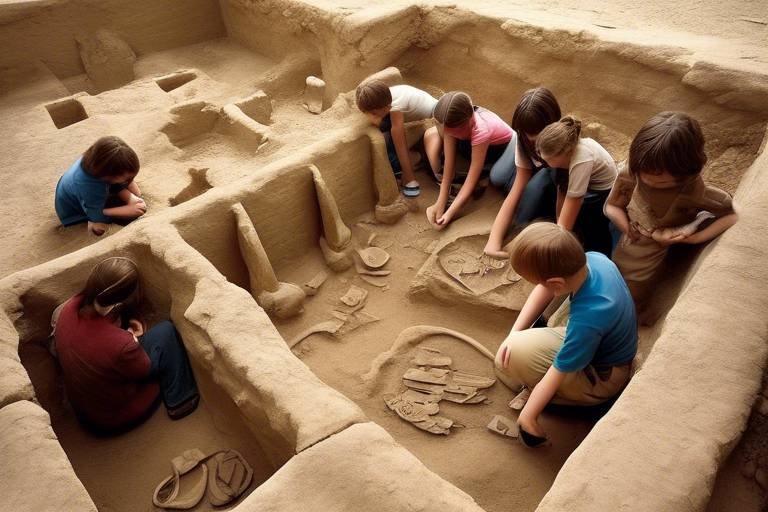The Importance of International Cooperation in Heritage Protection
Preservation of cultural heritage is not just a task for one nation; it is a global responsibility that transcends borders and unites nations in a common goal. The importance of international cooperation in heritage protection cannot be overstated. It is the cornerstone of safeguarding our shared history and ensuring that future generations can experience the richness of diverse cultures.
When countries come together to collaborate on heritage preservation efforts, they bring a wealth of knowledge, resources, and expertise to the table. Collaborative projects not only enhance the preservation and restoration of heritage sites but also foster a sense of mutual respect and understanding among nations. These partnerships ensure that heritage sites are not only preserved but also celebrated on a global scale.
UNESCO, as a key player in heritage conservation, plays a pivotal role in promoting international cooperation. Through its conventions, programs, and initiatives, UNESCO facilitates dialogue and collaboration among countries to protect and promote cultural diversity. By working together, nations can leverage UNESCO's expertise and guidance to develop sustainable conservation practices that benefit all.
Despite the benefits of international cooperation, challenges do exist in cross-border conservation efforts. Differing cultural perspectives, political tensions, and resource limitations can hinder effective collaboration. However, by acknowledging these challenges and finding common ground, nations can overcome barriers and work towards a shared goal of preserving our cultural heritage for future generations.
Advancements in technology have revolutionized heritage conservation, offering innovative tools for monitoring, documenting, and preserving heritage sites. These technological developments not only enhance conservation practices but also facilitate international collaboration by providing shared platforms for data sharing and analysis.
Education and awareness play a crucial role in sustainable heritage preservation. By promoting public understanding of the importance of heritage protection, nations can cultivate a sense of global responsibility and encourage active participation in conservation efforts. When individuals are empowered with knowledge, they become advocates for heritage preservation on an international level.
Engaging local communities in heritage conservation projects is another key aspect of fostering international cooperation. By involving communities in preservation efforts, nations can build a sense of ownership and pride in their heritage. This grassroots involvement strengthens partnerships between nations and ensures that conservation practices are sustainable and inclusive.
Securing funding and allocating resources for heritage protection requires international cooperation and partnership. By pooling financial resources and expertise, nations can ensure the long-term sustainability of conservation projects. Collaborative funding models and resource-sharing mechanisms are essential for addressing the financial challenges associated with heritage preservation.
The future of international collaboration in heritage protection holds great promise. Enhanced cooperation, innovative strategies, and shared responsibility among nations are key to preserving and protecting cultural heritage for future generations. By working together, countries can overcome challenges, leverage technological advancements, and build a more inclusive and sustainable approach to heritage conservation on a global scale.

Preservation Efforts Across Borders
Preservation efforts across borders play a crucial role in safeguarding the world's cultural heritage for future generations. Collaborative projects between countries not only enhance the preservation and restoration of heritage sites but also promote cultural exchange and mutual understanding on a global scale.
Through international cooperation, experts from different nations come together, pooling their knowledge and resources to tackle complex conservation challenges. This exchange of expertise leads to innovative approaches in heritage protection, ensuring that historical sites retain their authenticity and significance.
Moreover, cross-border preservation initiatives foster diplomatic relations and strengthen bonds between countries. By working together to protect shared heritage, nations build trust and solidarity, transcending political differences for the greater good of preserving cultural treasures.
UNESCO's World Heritage Centre serves as a hub for coordinating international efforts in heritage conservation. The organization facilitates partnerships between countries, providing a platform for collaboration on joint projects and the exchange of best practices in heritage protection.
By engaging in preservation efforts across borders, nations demonstrate their commitment to upholding the universal value of cultural heritage. These initiatives not only protect tangible heritage sites but also safeguard intangible cultural practices, traditions, and knowledge systems that are essential to our shared human experience.

UNESCO's Role in Heritage Protection
UNESCO, the United Nations Educational, Scientific, and Cultural Organization, plays a pivotal role in the protection and preservation of cultural heritage worldwide. Through its various conventions, programs, and initiatives, UNESCO fosters international cooperation to safeguard heritage sites and promote cultural diversity.
One of UNESCO's primary functions is to designate and protect World Heritage Sites, which are deemed to have outstanding universal value. By identifying and inscribing these sites on the World Heritage List, UNESCO aims to raise awareness about the importance of preserving these cultural and natural landmarks for future generations.
Moreover, UNESCO provides technical assistance and expertise to countries in need of support for heritage conservation projects. This assistance ranges from capacity building and training programs to emergency response initiatives in the event of natural disasters or conflicts that threaten heritage sites.
UNESCO also works towards fostering dialogue and collaboration among nations to address common challenges in heritage protection. By organizing conferences, workshops, and knowledge-sharing platforms, UNESCO facilitates the exchange of best practices and innovative approaches to conservation.
Furthermore, UNESCO's involvement in heritage protection extends beyond physical preservation efforts. The organization emphasizes the importance of intangible cultural heritage, such as traditional practices, rituals, and languages, in promoting cultural diversity and social cohesion.
In conclusion, UNESCO serves as a key player in promoting international cooperation in heritage protection by advocating for the safeguarding of cultural and natural heritage, fostering dialogue among nations, and raising awareness about the significance of preserving our shared heritage for future generations.

Challenges in Cross-Border Conservation
Preserving cultural heritage across borders presents a myriad of challenges that require careful consideration and strategic solutions. One of the primary obstacles in cross-border conservation efforts is the clash of differing cultural perspectives. Each nation has its own unique values, traditions, and approaches to heritage preservation, making it challenging to find common ground and establish unified conservation practices.
Moreover, political tensions between countries can impede international cooperation in heritage protection. Historical conflicts, territorial disputes, or diplomatic strains can hinder collaborative efforts to safeguard shared heritage sites and resources. Overcoming these political barriers requires diplomatic finesse and a commitment to prioritizing cultural heritage above political differences.
Resource limitations also pose a significant challenge to effective cross-border conservation. Not all nations have equal access to funding, technology, or expertise required for comprehensive heritage preservation. Disparities in resources can create imbalances in conservation efforts, leading to unequal protection of heritage sites and potential neglect of valuable cultural assets.
To address these challenges, stakeholders must engage in open dialogue, mutual respect, and knowledge sharing to bridge cultural divides and build trust among nations. Collaborative initiatives, capacity-building programs, and resource-sharing mechanisms can help overcome barriers to international cooperation in heritage protection. By working together and pooling resources, countries can ensure the sustainable preservation of cultural heritage for future generations.

Technology and Innovation in Heritage Conservation
Preservation of cultural heritage is crucial for future generations. International cooperation plays a vital role in safeguarding heritage sites, sharing expertise, and promoting mutual understanding among nations.
Collaborative projects enhance the preservation and restoration of heritage sites, ensuring their longevity and significance for global heritage.
As a leading organization in heritage conservation, UNESCO facilitates international cooperation through conventions, programs, and initiatives to protect and promote cultural diversity.
Differing cultural perspectives, political tensions, and resource limitations pose challenges to effective international cooperation in heritage protection efforts.
Advancements in technology offer new tools for monitoring, documenting, and preserving heritage sites, fostering international collaboration in conservation practices. Utilizing drones, 3D scanning, and virtual reality, experts can now analyze and recreate heritage sites with unprecedented accuracy and detail. These innovations not only streamline conservation efforts but also provide a deeper understanding and appreciation of cultural heritage on a global scale.
Promoting public awareness and education on the importance of heritage protection fosters a sense of global responsibility and encourages international cooperation in conservation efforts.
Engaging local communities in heritage preservation projects fosters a sense of ownership and pride, strengthening international partnerships for sustainable conservation practices.
Securing financial resources and allocating funds for heritage conservation projects require international cooperation and partnerships to ensure the long-term sustainability of preservation efforts.
Enhanced cooperation, innovative strategies, and shared responsibility among nations hold the key to preserving and protecting cultural heritage for future generations on a global scale.
Q: How can individuals contribute to heritage conservation efforts?
A: Individuals can support heritage conservation by participating in local preservation initiatives, promoting awareness, and respecting cultural heritage sites.
Q: What role does technology play in heritage protection?
A: Technology enables experts to monitor, document, and preserve heritage sites more effectively, fostering international collaboration and innovative conservation practices.
Q: Why is international cooperation essential for heritage preservation?
A: International cooperation allows for the sharing of expertise, resources, and best practices, ensuring the sustainable protection of cultural heritage for future generations.

Education and Awareness for Sustainable Preservation
Education and awareness play a crucial role in ensuring the sustainable preservation of cultural heritage. By educating the public about the significance of heritage protection, we can cultivate a sense of global responsibility and promote active participation in conservation efforts. Awareness campaigns, school programs, and informational resources serve as powerful tools in engaging individuals of all ages in understanding the importance of preserving our shared cultural legacy.
One effective approach is to incorporate heritage conservation into educational curricula, providing students with opportunities to learn about the value of heritage sites and the threats they face. By instilling a sense of pride and respect for cultural heritage from a young age, we can nurture a generation that is committed to safeguarding these treasures for the future.
Furthermore, public outreach initiatives, such as guided tours, workshops, and exhibitions, can enhance awareness and appreciation for heritage sites. These interactive experiences not only educate visitors about the historical and cultural significance of the sites but also encourage them to become advocates for their protection.
Collaboration with local communities is also essential in raising awareness and fostering sustainable preservation practices. By involving residents in conservation projects and empowering them to take ownership of their heritage, we can build strong partnerships that transcend borders and promote a sense of shared responsibility for safeguarding cultural treasures.
Ultimately, education and awareness initiatives serve as catalysts for promoting international cooperation in heritage conservation. By fostering a deeper understanding of the value of cultural heritage and the urgent need for its protection, we can unite nations in a common goal of preserving our diverse and rich heritage for future generations.

Community Involvement in Heritage Conservation
Community involvement plays a crucial role in the conservation of cultural heritage, fostering a sense of ownership and pride among local residents. By engaging communities in heritage preservation projects, a deeper connection to the cultural significance of heritage sites is established, leading to increased support for conservation efforts. This involvement not only ensures the physical protection of heritage sites but also contributes to the social and economic development of the local community.
Through community participation, traditional knowledge and practices related to heritage conservation are preserved and passed down to future generations. Local communities often hold valuable insights into the history and significance of heritage sites, making their involvement essential in developing sustainable conservation strategies. By including community members in decision-making processes and project implementation, a sense of shared responsibility and stewardship is cultivated, strengthening the bond between the community and the heritage site.
Collaboration with local stakeholders, such as indigenous communities or heritage custodians, is key to successful heritage conservation. These partnerships not only enhance the effectiveness of preservation efforts but also promote cultural exchange and mutual learning. By valuing and respecting the perspectives of local communities, international cooperation in heritage conservation becomes more inclusive and culturally sensitive, ensuring the preservation of diverse heritage practices and traditions.
Furthermore, community engagement in heritage conservation projects can stimulate tourism and economic opportunities for the local area. By showcasing the cultural richness and historical significance of heritage sites, communities can attract visitors, creating a sustainable source of income that supports both conservation initiatives and local livelihoods. This symbiotic relationship between heritage preservation and community development highlights the interconnectedness of cultural heritage and socio-economic well-being.

Funding and Resource Allocation for Heritage Protection
Preservation of cultural heritage is crucial for future generations. International cooperation plays a vital role in safeguarding heritage sites, sharing expertise, and promoting mutual understanding among nations.
Collaborative projects enhance the preservation and restoration of heritage sites, ensuring their longevity and significance for global heritage.
As a leading organization in heritage conservation, UNESCO facilitates international cooperation through conventions, programs, and initiatives to protect and promote cultural diversity.
Differing cultural perspectives, political tensions, and resource limitations pose challenges to effective international cooperation in heritage protection efforts.
Advancements in technology offer new tools for monitoring, documenting, and preserving heritage sites, fostering international collaboration in conservation practices.
Promoting public awareness and education on the importance of heritage protection fosters a sense of global responsibility and encourages international cooperation in conservation efforts.
Engaging local communities in heritage preservation projects fosters a sense of ownership and pride, strengthening international partnerships for sustainable conservation practices.
Securing financial resources and allocating funds for heritage conservation projects require international cooperation and partnerships to ensure the long-term sustainability of preservation efforts.
Enhanced cooperation, innovative strategies, and shared responsibility among nations hold the key to preserving and protecting cultural heritage for future generations on a global scale.
Q: How can individuals contribute to heritage protection efforts?
A: Individuals can support heritage protection by participating in local preservation initiatives, spreading awareness about the importance of cultural heritage, and respecting heritage sites when visiting them.
Q: Why is international cooperation crucial for heritage protection?
A: International cooperation is essential as heritage sites often transcend national boundaries, requiring collaborative efforts to ensure their preservation for future generations and promote cultural exchange.
Q: What role does technology play in heritage conservation?
A: Technology aids in monitoring, documenting, and preserving heritage sites, offering innovative solutions for conservation practices and facilitating international collaboration in heritage protection.

Future Prospects for International Collaboration in Heritage Protection
The future of international collaboration in heritage protection holds promising opportunities for safeguarding cultural treasures across the globe. As nations recognize the value of preserving their shared heritage, the potential for enhanced cooperation and innovative strategies becomes increasingly evident. By working together, countries can pool their resources and expertise to tackle conservation challenges on a larger scale, ensuring the long-term sustainability of heritage sites for future generations.
One key aspect of future prospects lies in the development and implementation of advanced technologies for heritage conservation. From 3D scanning and virtual reality to drones and satellite imaging, technological innovations offer unprecedented ways to monitor, document, and protect heritage sites. By embracing these tools and sharing knowledge internationally, conservation efforts can benefit from cutting-edge solutions and best practices.
Moreover, education and awareness initiatives play a crucial role in shaping the future of heritage protection. By promoting public understanding of the significance of cultural heritage and engaging communities in conservation projects, a sense of global responsibility can be fostered. Through educational programs and outreach activities, the next generation can be inspired to value and preserve their heritage, leading to increased international cooperation in heritage conservation.
Collaboration in funding and resource allocation is another vital aspect of future prospects for heritage protection. Securing financial support for conservation projects requires coordinated efforts among nations and organizations. By establishing sustainable funding mechanisms and transparent resource allocation processes, international partnerships can ensure the continued preservation of heritage sites for years to come.
Looking ahead, the prospects for international collaboration in heritage protection are bright. By embracing innovation, promoting education, engaging communities, and securing resources, countries can work together to safeguard the cultural legacy of humanity. Through shared responsibility and mutual respect, the future of heritage conservation holds the promise of preserving our rich heritage for generations to come.
Frequently Asked Questions
- What is the significance of international cooperation in heritage protection?
International cooperation is crucial in heritage protection as it allows for the sharing of expertise, resources, and best practices among nations. By working together, countries can better preserve and promote cultural heritage for future generations.
- How does UNESCO contribute to heritage protection?
UNESCO plays a key role in heritage protection by facilitating international cooperation through conventions, programs, and initiatives. It promotes cultural diversity and supports conservation efforts worldwide.
- What are the challenges in cross-border conservation?
Challenges in cross-border conservation include differing cultural perspectives, political tensions, and limited resources. Overcoming these obstacles requires effective communication, collaboration, and mutual understanding among nations.
- Why is community involvement important in heritage conservation?
Engaging local communities in heritage conservation projects fosters a sense of ownership and pride, leading to more sustainable preservation practices. Community involvement also strengthens international partnerships and promotes shared responsibility for heritage protection.
- How can technology contribute to heritage conservation?
Technology offers new tools for monitoring, documenting, and preserving heritage sites. Innovations such as drones, 3D scanning, and digital mapping enhance conservation practices and support international collaboration in heritage protection.



















